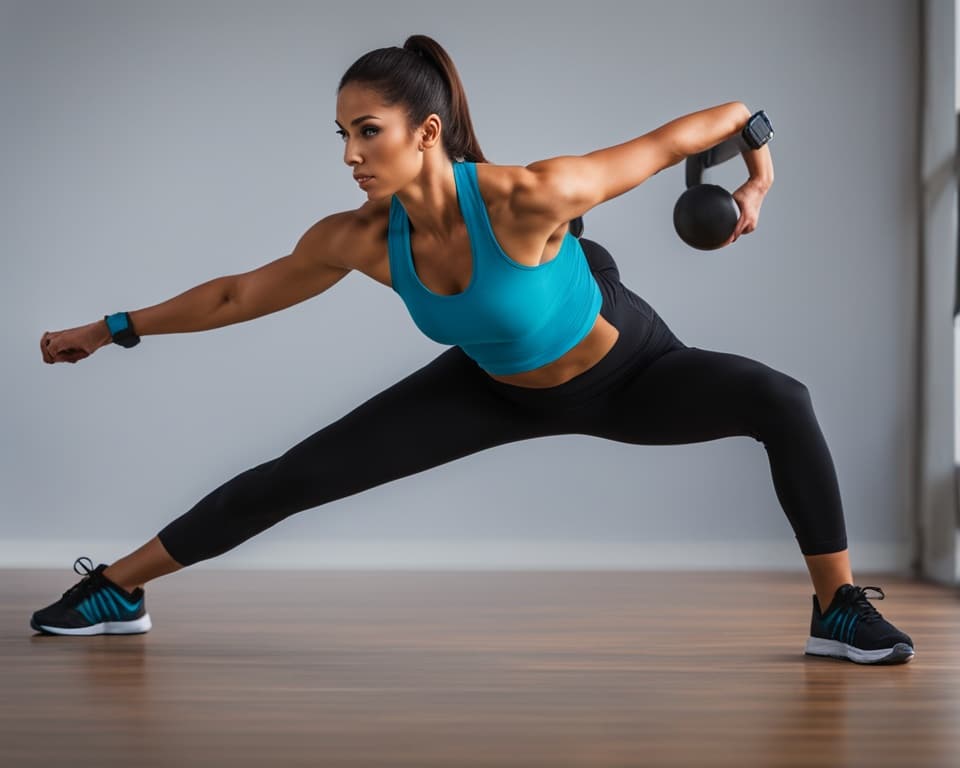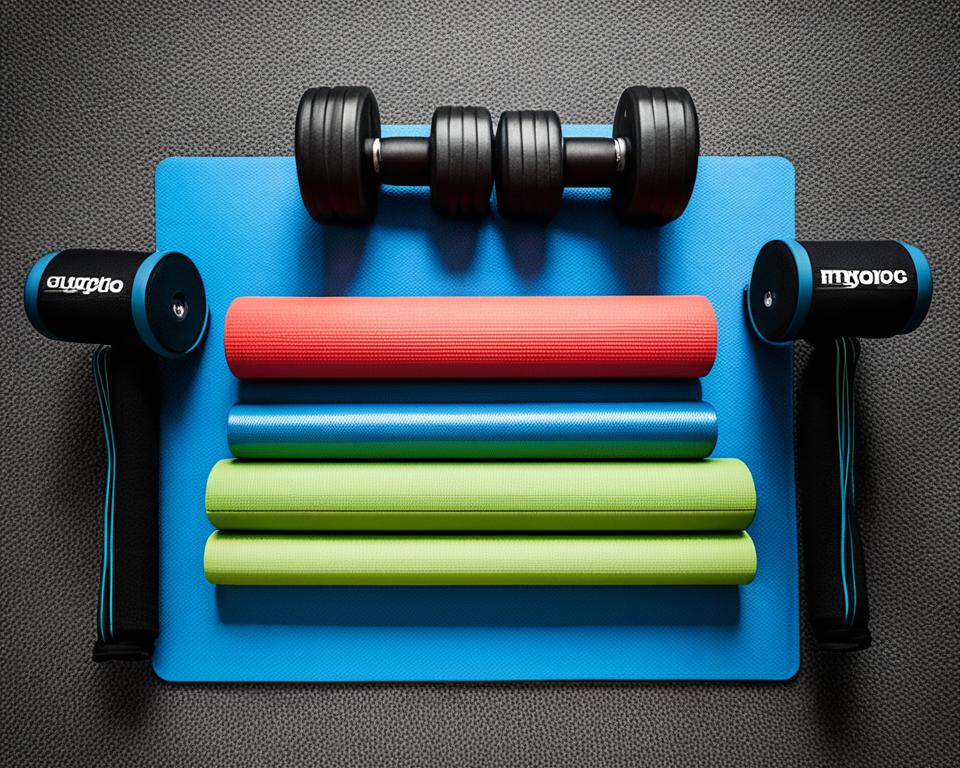
Master Warm Up Sets for Peak Muscle Performance
The sound of joints creaking and body heat rising seems quiet. Yet, when these hint at the start of warm up sets, they signal great muscle growth. A study involving 42 well-trained men showed how warm up routines can lead to major improvements. They tested their strength with different training methods. This study proved warm ups are more than just a start. They’re a way to boost performance, develop skills, and avoid injuries. This is key for serious training.
These men did more than just get better; they changed training rules. Over nine weeks, working out four times a week, they got stronger and stayed injury-free. Their success makes us ask, how do you warm up?
Warm up sets do more than get muscles ready. They prepare both body and mind for top-notch performance. As new research comes out, the fitness world adjusts, pushing athletes further. Think of these routines as your guide to reaching new highs. Let me show you how to navigate training, and hit your all-time bests.
Key Takeaways
- Structured warm up sets can significantly improve strength training outcomes.
- Warm up routines help prevent injuries by preparing the body and mind for rigorous activity.
- Dynamic warm-ups are more effective than static stretching for athletic development.
- Custom warm up sets tailored to the athlete’s needs enhance muscle performance.
- Pre-lift prep is both a physical and psychological primer for optimal performance.
- Integration of warm up sets into regular training is essential for sustained athletic improvement.
The Role of Warm Up Sets in Enhancing Muscle Performance
Effective warm up sets are key for the best workouts and protecting your muscles. They prepare you for high-level athletic performance by getting your muscles and heart ready. Let me show you how science and new approaches have made warm up routines essential for improving muscle function.
The Science Behind Warm Up Efficacy
Research shows warm up sets greatly improve muscle performance. Most injuries seen in sports clinics are muscle related, but warm ups can reduce these. By increasing body temperature and blood flow, warm ups ready the body for exercise. Importantly, cycling at moderate intensity after a workout can reduce muscle soreness, highlighting more benefits.
Transition from Static to Dynamic Warm Ups
Switching to dynamic warm ups is a major improvement in sports training. This change is supported by evidence that shows better muscle and strength outcomes. Dynamic warm ups, like sprint drills and lunging, mirror actual game movements. They boost oxygen flow and prepare your heart and muscles for the work ahead, unlike static stretching.
| Warm Up Component | Benefits | Activity Examples |
|---|---|---|
| Aerobic Warm Up | Raises body temperature, decrease muscle stiffness. | Walking, slow cycling. |
| Dynamic Stretching | Enhances muscular performance and flexibility. | Lunges, arm swings. |
| Cool Down | Aids in recovery, allows heart rate to return to baseline. | Slower paced workout continuation. |
| Injury Prevention | Reduces the risk of muscle tears and strains. | Dynamic stretching post-warm up. |
Including these steps is about more than avoiding injuries; it’s about being your best. Dynamic warm ups boost muscle power, setting the stage for great athletic acts. As your fitness guide, I stress the importance of starting strong with a smart warm up. This dynamic beginning greatly improves your sports performance, unlocking your training’s full potential.
Customizing Warm Up Sets for Optimal Athletic Readiness
The importance of warm up sets can’t be emphasized enough for top-notch performance. Getting ready for a race or intense workout? Custom warm up sets designed for your sport are key. I’ll show you how to nail your warm up sets routine for athletic readiness and to start strong.
First off, remember all warm up sets are different. Match the warm-up’s length and vibe to your event’s needs. A 30-minute warm-up is often just right for short, intense races, getting you ready to go. For longer endurance events, however, you might need a slightly extended warm-up to fully prime your muscles and cardiovascular system. Regardless of the event, treat your warm-up as a chance to mentally focus and prepare for peak performance. Just like finding the best rep tempo for hypertrophy in strength training, tailoring your warm-up to your specific needs can make all the difference in achieving optimal results on race day.

For longer races taking a few hours, a lengthier warm-up helps get your body set. Drinking and eating right before starting is crucial for your energy levels.
Identifying Key Muscle Groups
Finding the right muscles to warm up is vital for custom warm up sets. It’s about more than just moving; it’s preparing the muscles you’ll use the most. For uphill battles, your quads and calves need extra attention.
Warm Up Sets Across Various Sports
Here’s a quick guide on warming up for different sports. These tips are based on the following details:
| Event Type | Warm-Up Duration | Recommended Activity |
|---|---|---|
| Time Trials & Criteriums | 30 Minutes | Starting in Zone 2, Intervals Progression |
| Long Road & Mountain Races | Longer than 30 Minutes | Extended Aerobic Exercises, Hydration Focus |
| Track Events & Prologues | Longer than 30 Minutes | Higher Intensity Intervals, Race Visualization |
| Indoor Cycling | Shorter than 30 Minutes | Continuous Pedaling with Varied Intensity |
Small choices, like staying cool before a criterium, make a big difference. They help control your core temp, giving you an advantage.
In short, making your warm up fit your sport and personal needs is crucial for great results. Keep these tips and facts in mind for your next competition. Let them guide you to a warm up that switches you from relaxation to game mode seamlessly.
Mental Readiness: A Crucial Component of Pre-Exercise Prep
Getting your mind ready is key to doing your best in any tough activity. As someone who teaches muscle building, I focus a lot on getting your mind set before the real work begins. It’s not just about your body; your mind plays a big role too. When doing hard tasks or things that need a lot of skill, like construction or shoveling snow, you do your best when your mind and body work together.
Seeing the mental side in warm-up routines combines fitness with the need for attention. You need a basic level of fitness for everyday tasks. But to tackle more complex tasks, we must also focus on our mental state. This promotes alertness and stability. So, fitness should take care of both your health and skills. This balance is crucial for your body to work well as a whole.
| Component | Impact on Physical Fitness | Impact on Mental Readiness |
|---|---|---|
| Cardiorespiratory endurance | Facilitates efficient oxygen delivery | Increases stress tolerance and focus |
| Muscular strength and endurance | Enhances ability to perform demanding tasks | Builds confidence for peak performance |
| Flexibility | Improves range of motion for daily activities | Reduces anxiety related to physical limitations |
| Body composition | Affects ease of movement and efficiency | Influences self-perception and readiness |
To be fully ready in your mind, think about various factors. These include your age, gender, genes, health habits, how much you exercise, and what you eat. They all shape how well you can get ready for stressful tasks. By including warm-ups for both body and mind, an athlete can become truly prepared. This leads to training that is focused and effective. It helps them reach their top performance level.
Unlocking Performance Gains with Structured Warm Up Sets
I’ve seen the big impact structured warm up sets have on sports skills. Research shows well-planned warm-ups lead to big performance gains. Imagine a baseball player, ready and powerful, stepping up to play. This comes from mixing enhanced strength training with dynamic stretches. This blend boosts not just their strength but also improved flexibility.
- Starting with intense warm-ups like squats and lunges boosts agility and power. This is crucial for quick movements and crucial plays in a game.
- Indeed, adding agility drills and sprints shapes the core of performance gains. It’s a smart re-warm-up move that’s often missed.
Imagine a player who uses structured warm up sets to be at their best when the game starts. But, too long warm-ups can tire you out. That’s why including exercises like plyometrics and sprints is key. They make your strength training better and help you explode into action when playing.
| Warm-Up Aspect | Beneficial Impact | Detrimental Impact |
|---|---|---|
| Structured Warm-Up Sets | Improvement in sprint, jump, and agility performance | Passive rest resulting in decreased performance |
| Heat Garments | Significant improvement in sprint performance | N/A |
| Eccentric Exercises | N/A | Detrimental to sprint and jump performance during re-warm-up |
| Plyometric Training | Enhanced agility, power, and quickness | N/A |
To sum up, if you’re serious about baseball or any sport, embracing improved flexibility and a complete warm-up is key. Proper warm-ups strengthen muscles and sports smarts. Listen to the research, improve your prep, and you’ll see major performance gains.
Best Practices for Warm Up Set Execution
Knowing how to warm up sets properly is crucial for top performance. Warm-ups should start easy and move to exercises that match your sport. We aim to use best practices for warm up sets to get the most out of them, tailored to each person’s body and goals.
From Low Intensity to Sport-Specific Movements
I always suggest beginning with easy exercises, like slow jogging or dynamic stretching. This approach gets your body ready for tougher activities and helps stop injuries. Over time, include movements specific to your sport to get muscles and functionality ready for what’s next.
Managing Warm Up Duration for Maximum Benefit
How long to warm up is a common question. Aim for 10-30 minutes, which is just right. This time frame gets you ready, without cutting into your main workout. A good warm-up gets muscles ready and helps your training pay off more over time.
Look at this recent research. It shows why warming up is key, especially in high-stakes areas like high-frequency trading:
| Action | Effect |
|---|---|
| Low-latency critical path warming | Essential for optimal application performance |
| CPU cache warming | Minimizes latency post-blocking operations |
| Warm-up runs (12k) | Enhances code optimization and performance |
| Allocation below 300 KB/sec | Enables efficient garbage collection once daily |
| Object re-use within allocation budget | Reduces need for new allocations, maximizing application responsiveness |
For strength training, a proper warm up readies muscles and nerves for heavy lifting. Understanding this helps us choose the best workout plans for better results. For example, doing a warm-up set at 90% 1RM load can really boost your strength exercise results.
Whether you’re aiming to be faster, lift more, or have your software run smoothly, focusing on your warm-up can change the game. It’s not just the exercises; it’s making them work for your specific aims. That’s the key message. The quality of your warm-up sets the stage for your performance.
Implementing the RAMP Protocol for Superior Warm Ups
As a muscle building mentor, I always talk about the need for a good warm-up plan. The RAMP protocol isn’t just something to do before the real workout. It’s essential for getting the body ready for top effort. Many start their workout with heavy weights, but RAMP’s steps – Raise, Activate & Mobilize, and Potentiate – make warming up more targeted and effective.
Phase Breakdown: Raise, Activate, Mobilise, and Potentiate
The Raise stage starts things off with gentle activities that boost blood flow and warm up muscles. It does this without using up much energy. Next, in the Activate & Mobilize phase, we focus on exercises that get the muscles and joints ready. Finally, in the Potentiate phase, we increase the challenge to mirror what will come in the main workout, whether it’s lifting weights or another sport.
Examples of the RAMP Protocol in Action
A way I put this into practice is by having athletes cycle on a stationary bike with light resistance before doing heavy squats. This method is backed by evidence showing that dynamic activities enhance muscle readiness. It’s important that each warm-up is personalized. This includes adjusting the number of sets and rest times to match individual goals and fitness levels.
FAQ
What are warm up sets and why are they important for muscle performance?
Warm up sets are exercises you do before your main workout. They help your heart rate, blood flow, and muscle temperature go up. This makes injuries less likely and makes muscles work better.
They get your muscles and joints ready for heavier loads. They also make muscles more flexible and powerful. This leads to better performance in sports.
How do warm up sets enhance muscle performance?
Warm up sets make muscles work better by warming them up and making them flexible. This results in faster muscle responses and improved strength. When muscles are warmed up, they are stronger and more explosive. This is key for activities like lifting weights or running fast.
What is the difference between static and dynamic warm ups?
Static warm ups involve stretches you hold still. They might not prepare you well for moving activities. Dynamic warm ups, however, involve active movements. They better prepare your body for exercise by warming you up and mimicking the actions you’ll do.
How can I tailor my warm up sets for my specific sport?
To tailor warm ups for your sport, focus on the main muscles and movements it involves. Include warm up exercises that engage and ready these areas. Doing this will ensure you’re prepared for the physical demands of your sport, improving your performance.
Why is mental readiness important in my pre-exercise routine?
Mental readiness is key because it helps you focus on your training instead of other things. A good warm-up readies both your body and mind. It sharpens your focus for better, more targeted training sessions.
What are some performance gains I can expect from structured warm up sets?
Structured warm up sets can boost muscle strength, power, and flexibility. They include exercises that prime your muscles for explosive movements. This means better performance in your workout or sport.
How should I properly execute warm up sets?
Start your warm up with easy exercises, then gradually move to those that are more intense and related to your sport. Keep your warm up to 10-30 minutes. This way, your body is ready but not tired before your main workout.
What is the RAMP protocol and how does it apply to warm up sets?
The RAMP protocol stands for Raise, Activate, Mobilise, and Potentiate. It’s a step-by-step approach to warm-ups. It increases blood flow, wakes up key muscles, makes joints more flexible, and gets muscles fully ready. It’s great for anyone, from beginners to pros, and can be adjusted for any sport.
Can you provide examples of exercises for each phase of the RAMP protocol?
For ‘Raise’, try light jogging or dynamic stretches. ‘Activate’ involves movements like leg swings. They target specific muscles. For ‘Mobilise’, do movements that increase your joint flexibility. ‘Potentiate’ focuses on sports drills or plyometrics that ready you for the main activity.
Who can benefit from implementing warm up sets into their routine?
Anyone active, from newcomers to experienced athletes, can gain from warm up sets. They ready your body for exercise, enhance your performance, and reduce injury risks. They’re essential for everyone’s workout preparations.



